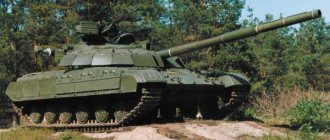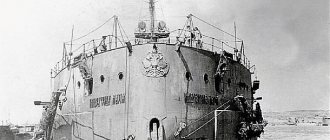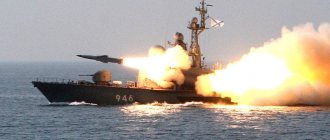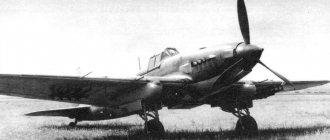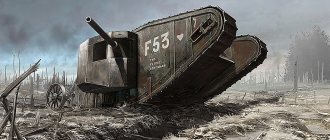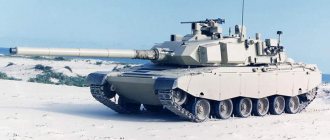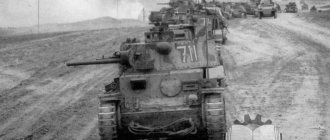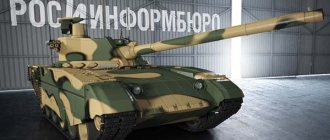V-2 is a Soviet V-shaped 12-cylinder four-stroke diesel tank engine with water cooling and jet fuel atomization.
The V-2 engine in its original form spent more than 20 years in military service.
Some copies are still in use today. Several more found peace in various museums. Letter indices for mechanical engineering industries, introduced by the USSR government in the 1930s, began to be used in the names of products developed in these industries.
Index “B” was assigned to the diesel shop of the Kharkov Locomotive Plant. Therefore, the diesel engine developed and mastered in this workshop was given the name “B-2” in 1937. “2” is the number of the sample accepted for production. The V-2 engine was developed in 1931-1939 by the design team of the diesel department of the Kharkov Locomotive Plant, first under the leadership of K. F. Chelpan, and then, from 1938, under the leadership of T. P. Chupakhin, his deputy for design work - Ya. E Vikhman, deputy for experimental production work - I. Ya. Trashutin. At the end of the 20th century, a major contribution to the creation of modern modifications of the V-2 tank diesel engine was made by the chief designer (since 1981) of the head design bureau for ChTZ engines, V.I. Butov.
Simultaneously with the B-2, in the 1930s, the AN-1 aviation diesel engine, designed by A. Charomsky, with a working volume of 61 liters (12H 18/20) was created. Both diesel engines were similar in the nature of the working process, in the general layout and a number of structural elements.
Serial production of the B-2 began on September 1, 1939. Adopted by the Red Army in the same year in three modifications: V-2 (500 hp), V-2K (600 hp) for heavy KV tanks and V-2V (375 hp). By the beginning of the Great Patriotic War, Engine Plant 75 had mastered five diesel modifications: V-2 (for the BT-7M light tank and the first series of the medium T-34), V-2-34 (after modernization in 1941 for the T-34), V-2K (for heavy tanks KV-1 and KV-2), V-2V (for the Voroshilovets tractor) and six-cylinder in-line V-4 (for the light tank T-50). There is also information about the pre-war experimental B-5 with power up to 700 hp.
During the war, designers Vikhman and Fedotov developed the V-2IS engine for the IS tank (520 hp, experimental versions were boosted to 650 hp). One of its advantages was an electric inertia starter, which worked both from an electric drive and from a handle. An additional air launch was also left in place. In the fall of 1943, the development of new, more advanced modifications for heavy tanks began in Chelyabinsk. The result of this work was the V-11 engine, which served as the prototype for all subsequent naturally aspirated diesel engines V-44, V-54, etc. In addition to the above-mentioned production ones, several experimental modifications were also developed for heavy tanks, for example, one with speed boosted to 700 hp. V-2SF and V-2SN with a centrifugal supercharger from an AM-38 aircraft engine. The V-2SN developed power up to 850 hp. and was tested on the IS-3 tank. Subsequently, a 750-horsepower V-12 with a supercharger from the AM-38F was developed and tested, the first production supercharged one.
Before the Great Patriotic War, it was produced only at Engine Plant No. 75 (a branch of the Kharkov Locomotive Plant), the contractors were KhTZ, Chelyabinsk and Kirov (Leningrad) plants. After the start of the war, it was produced at the Stalingrad Tractor Plant and in Sverdlovsk at Plant No. 76. In October 1941, Plant No. 75 was evacuated to Chelyabinsk to the ChTZ site. The Kirov plant also moved there. All of them were united into a huge Tank City. This plant became the main manufacturer of B-2s during the war (about 50 thousand engines, including engines produced in Kharkov). Later, in 1942, production of the B-2 was mastered at plant No. 77 in Barnaul.
V-2 engine design
Volume 38.8 liters, compression ratio 14 and 15. Rated engine power was 450 hp. at 1750 rpm, operational - 400 hp. at 1700 rpm, maximum - 500 hp. at 1800 rpm. Engine weight is about 1000 kg. Cylinder diameter 150 mm. The piston stroke of the left group is 180 mm, the right one is 186.7 mm. The cylinders were arranged in a V-shape at an angle of 60°.
Initially, the engine was developed for use in aviation - on heavy bombers. This circumstance determined some design features of the diesel engine, uncharacteristic for engines of land vehicles, and determined the very high technical perfection of the engine. Among them:
- lightweight design with extensive use of light alloys (however, in the middle of the war, due to a lack of aluminum, it was necessary to temporarily replace silumin with cast iron);
- overhead camshafts, two in each engine head (DOHC);
- 4 valves per cylinder;
- dry sump;
- direct fuel injection, jet mixture formation;
- drive of all engine units and systems via bevel gears and intermediate inclined shafts;
- the use of steel studs as the main force element for tightening the head, cylinder block and crankcase.
However, it was not possible to bring the power to the requirements of aviators (1000-1500 hp) even by using supercharging, and the engine design was adjusted for installation on tanks.
About the Abrams tank engine
The Abrams are notable for the fact that, unlike many models of modern tanks that are equipped with diesel engines, they are equipped with a gas turbine engine! This unit is called AVCA Lycoming AGT-1500, producing 1500 hp. This is a three-shaft engine, which is equipped with a two-stage axial-centrifugal compressor, a free power turbine, and a tangential combustion chamber. To ensure effective cooling of the nozzles and rotor blades of the first stage of the turbine, air is used, which is taken from the compressor outlet. Next, air is supplied through specially designed holes in the blade shanks. This engine is distinguished by its lighter weight compared to diesel engines, simplicity of design, increased service life and high reliability. In addition, the AGT-1500 is better suited to multi-fuel requirements, pleases with its less noise and has reduced smoke. The list of advantages also includes easier startup of this “gas turbine” at low temperatures. It has high throttle response, making it possible to accelerate the tank in six seconds to a speed of thirty km/h. True, there are a couple of disadvantages - increased fuel and air consumption. As a result, the air purification system is an analogue of car filters, three times larger in size than conventional diesel units. In addition, in desert conditions such engines often fail because they “choke” with sand and dust. AGT-1500 is made in one unit with an automatic hydromechanical transmission, which ensures high maintainability of the machine under field conditions. It will take no more than one hour to replace the unit.
V-2 engine family
The V-2 engine is the founder of a whole family of high-speed diesel engines. In addition to the 12-cylinder serial modifications of the B-2 (B-2K and B-2B), before the war, a “half” of the twelve-cylinder diesel engine was also developed under the designation B-4, but its history was not very successful. In 1941, the B-2 was modernized and received the name B-2-34. During the war, the V-2IS (aka V-2-10), V-2-34M (aka V-34), V-2-44 (aka V-44) and V-11- were developed and began to be produced. IS-3.
In 1945-1946, under the leadership of J. Vikhman, SKB-75 (the engine design bureau at ChTZ) completed the development of the V-12, intended for the IS-4 tank. From 1949 to 1950, for another heavy tank, the T-10, a 700-horsepower V-12-5 (A-5) engine was developed, which, in particular, used a supercharger from the AM-42, some innovations of which were used in 1950 year when upgrading the engine to V-12M. In 1953, by replacing the generator from a three-kilowatt to a five-kilowatt one, the V-12-5B (A-5B) engine was created, which went into production in 1956. A more serious modernization took place in 1954, when the V-12-6B (A-6B) was developed, which went into production three years later. A modification with a 1.5 kW more powerful generator received the index B12-6B (A-6B) and was put into mass production the next year; the need for this was caused by the increased energy consumption of new stabilizers.
Engine V12-6. View from the toe side: 1 - water pump; 2 — engine mounting foot; 3 - oil filter
Engine V12-6. View from the supercharger side: 1 — fine fuel filter; 2 - supercharger; 3 — fuel pump BNK-12TK; 4 - pipeline for supplying oil to the fluid coupling; 5 — fluid coupling of the generator drive; 6 — pipeline for draining oil from the fluid coupling; 7 — generator; 8 - manifold for distributing coolant among the cylinders
In addition to improving the characteristics of ChTZ serial products, development work was also carried out, which resulted in a preliminary design of the 850-horsepower V-7 in 1954 and the B12-7 (A-7) with a power of 1000 hp. in 1956. The latter was tested in the Object 770 heavy tank and a mock-up of the Object 282 missile tank in 1959. At the same time, due to problems with the transmission and chassis, the experimental T-10M (Object 272) with an 800-horsepower V12-6F (A- 6F). Finally, in 1962-1963. Experiments were carried out with the multi-fuel V-12-6BM. For several decades after the war, in addition to V-12 diesel engines, the family was replenished with tank engines V-45, V-46, V-54, V-55, V-58, V-59, V-84, V-85, V-88 , V-90, V-92, V-92S2F (V-93) and their various modifications, both serial ones, produced mainly at ChTZ, and experimental ones.
The 580-horsepower V-55V engine was used on T-62 tanks produced from 1961 to 1975. In total, about 20,000 vehicles were produced - the tanks themselves and various equipment created on their basis
The V-46 engine is used on the T-72 medium tanks, which have been put into service since 1973. Thanks to the supercharging system, 780 hp were produced.
Based on the V-2 engine, in the second half of the 40s - in the early 50s, lightweight high-speed diesel engines were created and mastered at Barnaultransmash for various sectors of the national economy - first six-cylinder D6, and then 12-cylinder D12. The deformed D6 is widely used on river vessels. The 3D6 engine was installed on:
- Project 1606 tug boats "Kostromich" (both 3D6 and 3D6N)
- river trams "Moskvich"
- river trams "Moscow"
- tugs BM, BV;
- service and traveling boats of projects 371 “Admiralsky” and 376 “Yaroslavets”
The 3D12 engine was installed on:
- tugs LS-56A,
- RT project 911A and, later, for individual river basins on vessels of project 911B;
- hovercraft "Luch" (boosted to 520 hp).
Modification 1D6 was used on the diesel locomotive TGK2, the DGK railcar (broad gauge), and 1D12 was used on heavy-duty vehicles MAZ-525 and MAZ-530, diesel locomotives TU2, TU7 of narrow (750 mm) gauge railways, diesel locomotives TGM1, TGM23, TGM40 normal ( 1520 mm) track. It was also used in the Armed Forces of the USSR and the Russian Federation as a drive for the AD-100 (100 kW) alternating current generator.
The DET-250 tractor was first equipped with an engine of this family, V-748, later V-30, V-31. The AT-T all-terrain tracked tractor, as well as engineering vehicles built on its chassis (MDK-2, BAT-M, BTM-3), were equipped with A-401 and B-401 engines. The IMR engineering clearing vehicle, created on the basis of the T-55, had a B-55 engine.
Based on the engines of the V-2 family, at the end of 50 - beginning of 60, a new generation of tank engines - UTD (universal tank diesel) was created at Barnaultransmash under the leadership of chief designer B. G. Egorov. At the same time, technological continuity with the production of V-2 (D-12) engines was largely maintained. In particular, such important indicators as the distance between the axes of the cylinders (175 mm) and the diameter of the cylinders (150 mm) are the same as the V-2. The first to be launched in the series in 1965 was the six-cylinder UTD-20 with a reduced height (in comparison with the V-2) due to the cylinder camber angle increased to 120° and a 15/15 dimension with a power of 300 hp. for BMP-1 and BMP-2. Option for BMD-1 and BMD-2 with 240 hp. at lower speeds it received the designation D-20. For the BMP-3, the ten-cylinder UTD-29 was developed at the end of the 80s.
The successor to the V-2 is also a new generation of X-shaped four-stroke tank diesel engines produced by ChTZ of the 2B family in dimensions 15/16. The first-born of this family in the series was the six-cylinder (half of the X-12) “boxer” 2B-06 for the BMD-3 and BTR-90.
Diesels D12 and V-2, which were basically developed in the 30s, even at the beginning of the 21st century are characterized by high specific parameters, their specific weight is only 2.05 kg/hp, and specific fuel consumption is 165 g/ hp h The disadvantages are mainly due to technological and other limitations that existed at the time of engine development and its launch into production, in particular:
- inefficient operation of oil scraper rings of an outdated design - as a result, high oil consumption due to waste - 20 g/hp h;
- a complex camshaft drive circuit containing a large number of mechanical gears (in the 1930s there were no drive chains capable of operating at high speeds) - as a result - increased noise levels, low service life, difficulty in maintenance;
- a complex prefabricated crankshaft, the cost of which is about 30% of the entire engine - in the 1930s there were no methods for volumetric stamping of such large parts;
- ineffective electric starting system (low efficiency of ST-712 starter, non-optimal gear ratio);
- high rate of increase in pressure on the piston group (the so-called rigidity of engine operation), leading to a decrease in the overall resource. The reason for this is not entirely effective mixture formation, which is largely determined by the chosen shape of the combustion chamber, the number of nozzle holes and some other details;
- the lack of joint balancing of the crankshaft and flywheel does not significantly increase the service life.
Assembling and tuning the engine using unskilled labor led to defects in production, especially in the early months of the war. Due to the lack of high-quality valve adjustment and the complex multi-gear design of the transmission from the flywheel to the timing belt, valves meeting pistons became a very common occurrence. The engines of the first production could not always reach the standard 50 engine hours even in bench conditions; at the same time, the design, for all its complexity, still ensured high maintainability, right up to the engine overhaul in the field. However, over the many years of serial production of diesel engines V-2, D12 and D6, their design, despite the emergence of new materials and technical solutions that make it relatively easy to eliminate these shortcomings, has undergone virtually no changes.
Tank engines: what are they? Specifications
Traditionally, tank engines are subject to rather stringent operational requirements, because in any conditions they must operate without failure, guarantee the tank high maneuverability, and be easy to repair and maintain.
The fact is that in combat conditions the engine may suddenly need to be repaired or even replaced, which must be done as quickly as possible. And because of this, the effectiveness of using a particular tank model depends not so much on its armor protection and firepower (these indicators naturally come first on the list), but on the engine. In our time, the best modern models of tanks that are now in service in various countries of the world are considered to be the Leopard of German origin, the American Abrams, the good old Russian T-90, the French Leclerc, the Israeli Merkava and the British Challenger. . Of course, their engines should deservedly be considered one of the best in the world, and each of them has its own characteristics and nuances, pros and cons. So let's start the review.
Merkava Mk 4
The Israeli tank was first demonstrated at a weapons exhibition on June 24, 2002, but was officially handed over for field testing in December 2001. Serial production of the new Merkava model began after the Merkava Mk 3 model was removed from the assembly line at the beginning of 2003.
Merkava tank, which means "chariot" in Hebrew
The tank has a built-in 120mm cannon that fires advanced multi-purpose and anti-tank shells. The vehicle has a modern fire control system and a unique combat control system that provides a clear and precise picture of what is happening outside - both systems were created by Elbit Systems.
Mk 4 is considered one of the most powerful tanks of our time
The Merkava Mk 4 uses a V-12 diesel engine, allowing it to exceed 60 km/h. Hidden inside the tank is a life support system: ventilation, biological, nuclear and chemical filtration systems, as well as individual cooling systems and power generators.
About the engine of the Merkava 4 tank
This model of the Israeli tank is in service exclusively with the Israeli Armed Forces, and there are no plans to export it. The fact is that the country’s leadership is afraid and wants to prevent its technologies from getting into Arab states that are unfriendly to Israel. The latest modification of the tank is the Merkava 4, however, the troops are still actively using previous modifications of the model of this combat vehicle. This tank’s distinctive design feature is the “vehicle placement” of the engine and transmission - that is, in the front, because traditionally, a tank layout means the engine being located in the rear of the tank. This guarantees greater crew survivability. The Four is equipped with a GD883 diesel engine of American origin from General Dynamics. It is water cooled and produces 1500 hp. This engine is a licensed “twin” of the German GD883 diesel engine. Previous versions of the tank have American AVDS-1790-5A diesel engines, that is, the fuel supply adjustment is controlled by an electro-hydraulic system. A special feature of the Merkava engine is a special oil pan, which is connected to an additional flat oil tank. And thanks to this, the engine is able to operate with any differentials, loads and rolls. The engine is controlled by a computer, which displays all information on the driver’s monitor. The tank engine is made in one block with an automatic transmission. Replacement of this unit in the field requires only less than one hour.
T-14 "Armata"
A new generation tank, developed by Russian designers in 2009. "Armata" is an innovative universal tracked platform; In the future, it is planned to create a whole family of combat vehicles based on this TSUP. The newest Russian tank T-14 “Armata” Other innovations include a single armored capsule for 3 crew members, separating the room with people from ammunition and fuel tanks, which increases the safety and efficiency of crew communication. In general, the “living” space has become more spacious and comfortable, and the ergonomics of the controls have been improved.
T-14 at the Victory Day parade in 2015
The T-14 has 4 levels of protection: stealth paint, Afghanit KAZ, electromagnetic mine protection system, as well as dynamic armor, which also covers the roof with hatches.
The T-14 is armed with a 125-caliber smoothbore cannon with the ability to launch guided missiles. To combat infantry, a remote-controlled machine gun is provided. The standard T-14 projectile is the 90-centimeter BPS Vacuum-1.
According to the latest news, the T-14 will undergo state tests in 2016.
The weight of the tank is 50 tons, the speed is up to 75 km/h, and its engine power is 1500 horsepower (optimal is 1200). The Ministry of Defense plans to replace the T-72 and T-90 models with the latest tank. It is expected that the Russian army will take the new product into service by 2020.
